Home / Huckel’s Rule: What Does 4n+2 Mean?
Aromaticity
Huckel’s Rule: What Does 4n+2 Mean?
Last updated: June 26th, 2025 |
Hückel’s Rule: What Does 4n+2 Mean?
“4n+2 is not a formula that you apply to see if your molecule is aromatic. It is a formula that tells you what numbers are in the magic series. If your pi electron value matches any number in this series then you have the capacity for aromaticity.” – a wise student
Table of Contents
- If You’re Looking For “n” In A Molecule, You’re Looking For The Wrong Thing
- “n” Is Not A Characteristic Of The Molecule!
- In Huckel’s Rule, The Formula (4n+2) Is An Algebraic Expression Of The Series 2, 6, 10, 14… Where ‘n’ Is A Natural Number
- Summary: “n” Comes From Algebra, NOT From Chemistry
- Notes
- Quiz Yourself!
- (Advanced) References and Further Reading
1. Stop Looking For “n” In A Molecule, Because You’re Looking For The Wrong Thing
The other night a student came to me with a question about aromaticity.
“There’s one thing I don’t get”, she said. “They say a molecule has to have 4n+2 electrons to be aromatic. How do you find ‘n’ ?”
Teachable moment!

2. In the [4n+2] Rule (“Huckel’s Rule”), “n” Is Not A Characteristic Of The Molecule!
“n” is not a characteristic of the molecule! Let me explain.
In order for a molecule to be aromatic, it has to have the following characteristics:
- It must be cyclic
- It must be conjugated (i.e. all atoms around the ring must be able to participate in π-bonding through resonance)
- It must be flat
3. In Huckel’s Rule, The Formula (4n+2) Is An Algebraic Expression Of The Series 2, 6, 10, 14… Where ‘n’ Is A Natural Number
- For n = 0, we get (4 × 0 + 2) = 2
- For n = 1, we get (4 × 1 + 2) = 6
- For n = 2, we get (4 × 2 + 2) = 10
- For n = 3, we get (4 × 3 + 2) = 14
- For n = 4, we get (4 × 4 + 2) = 18
4. Summary: “n” Comes From Algebra, NOT From Chemistry
Notes
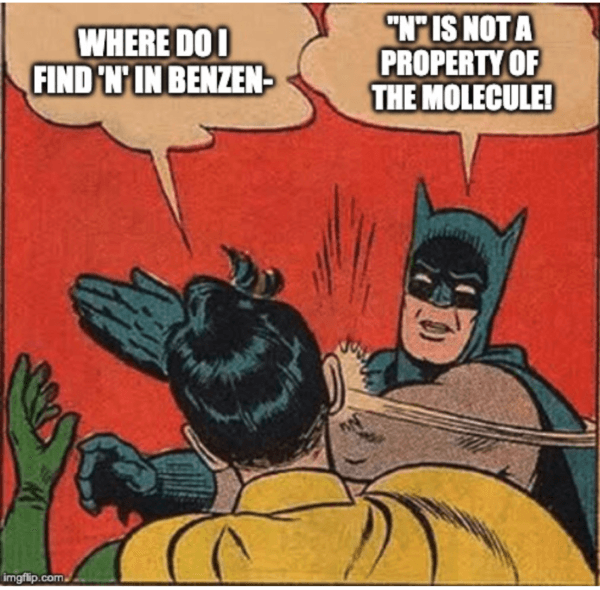
Related Articles
Quiz Yourself!

Become a MOC member to see the clickable quiz with answers on the back.
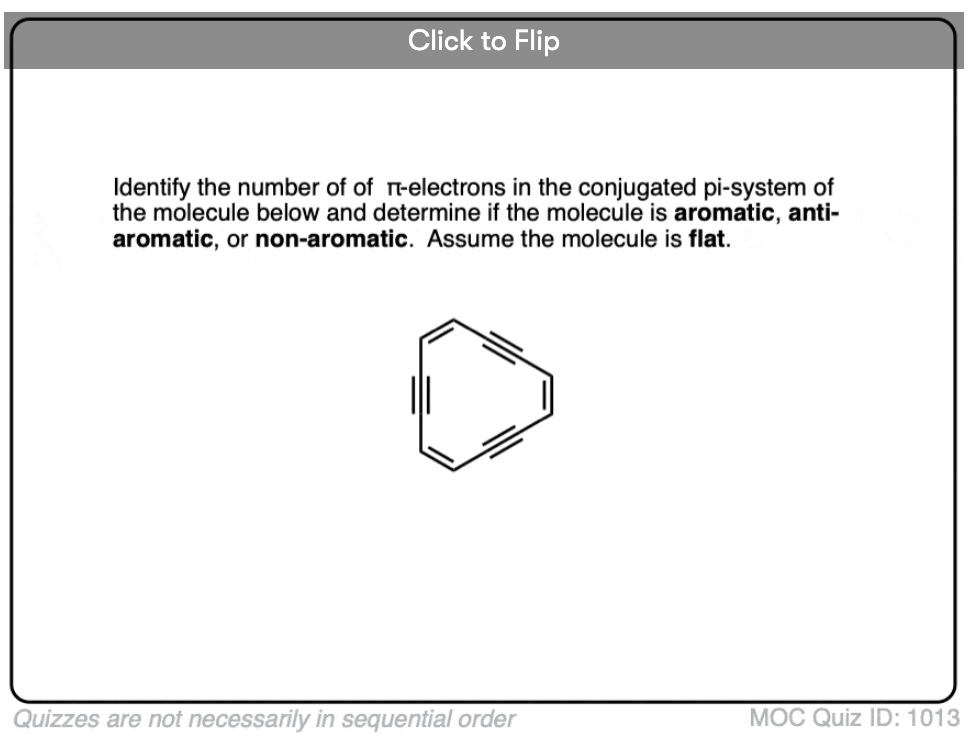
Become a MOC member to see the clickable quiz with answers on the back.
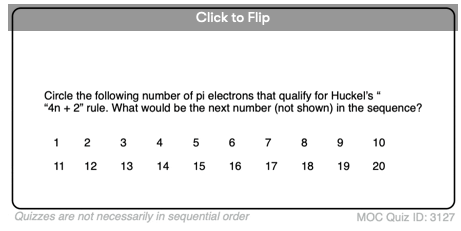
Become a MOC member to see the clickable quiz with answers on the back.
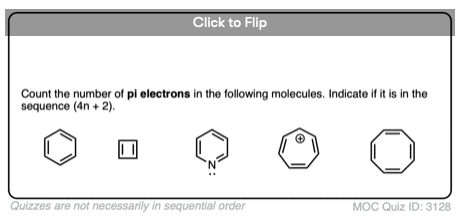
Become a MOC member to see the clickable quiz with answers on the back.
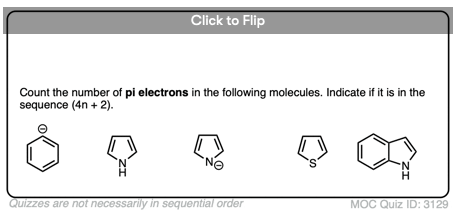
Become a MOC member to see the clickable quiz with answers on the back.
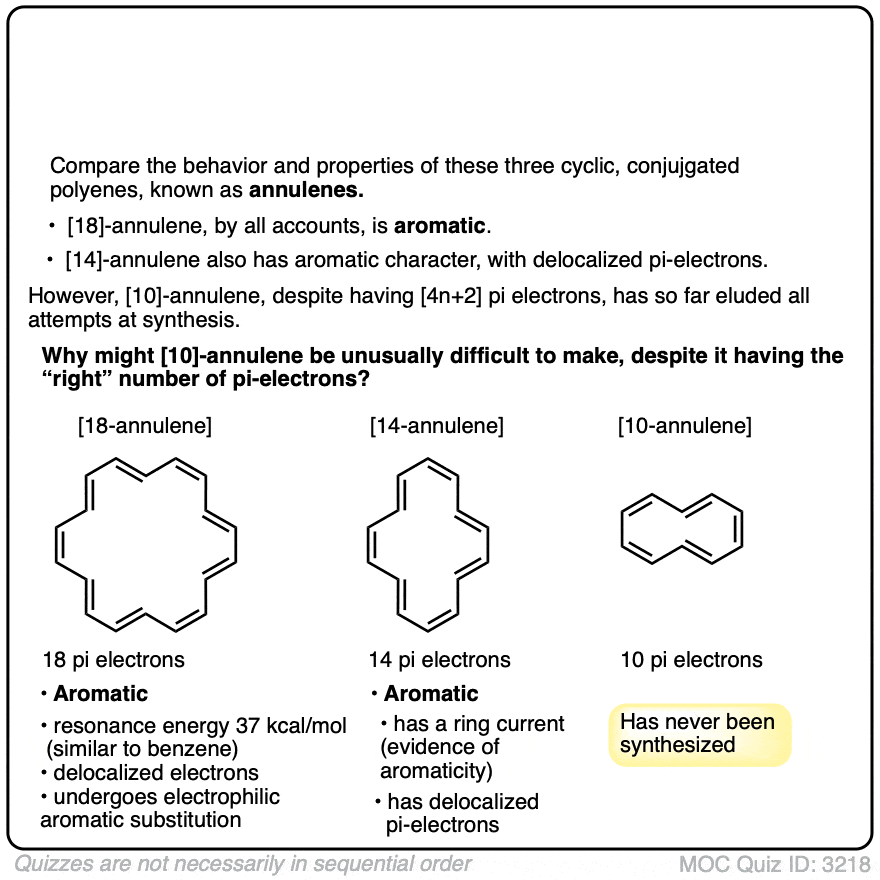 Click to Flip
Click to Flip
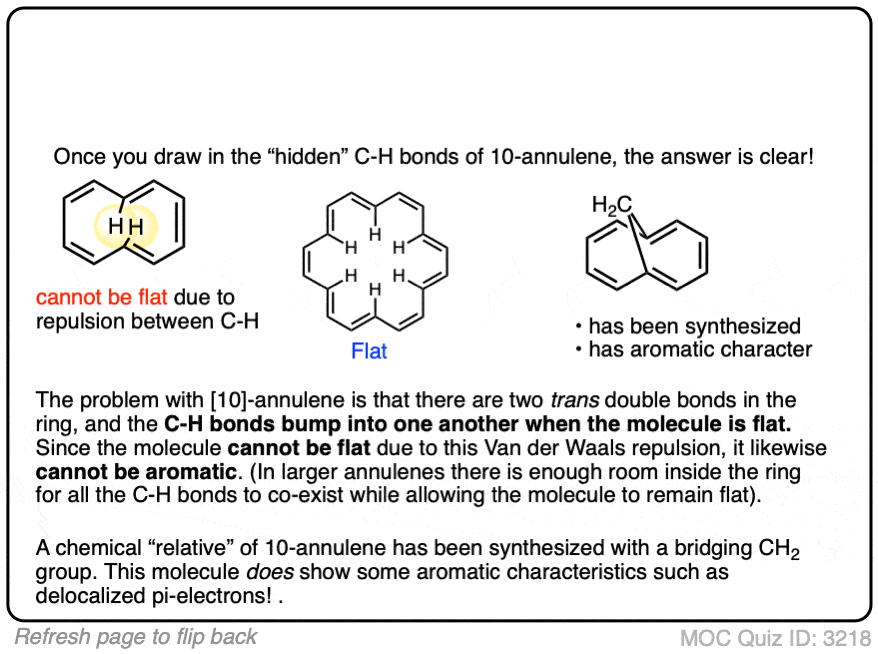
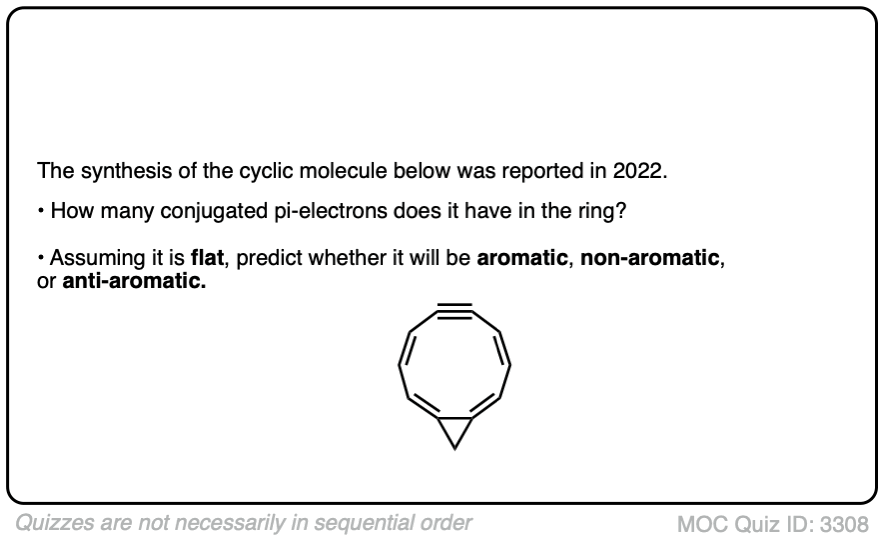 Click to Flip
Click to Flip
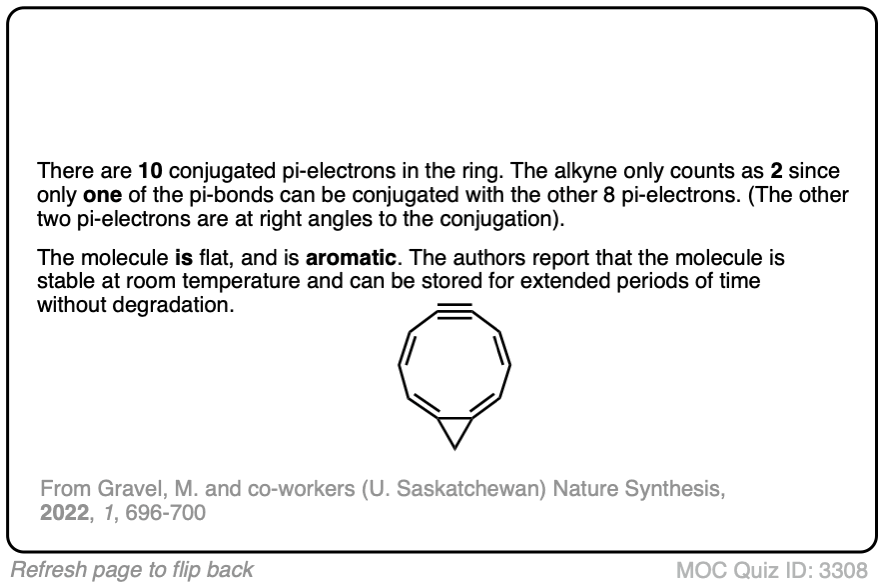
(Advanced) References and Further Reading
- CYCLOHEPTATRIENYLIUM OXIDE
W. von E. Doering and Francis L. Detert
Journal of the American Chemical Society 1951 73 (2), 876-877
DOI: 10.1021/ja01146a537
In this paper, esteemed Harvard chemist William Eggers von Doering succinctly summarized the Huckel rule as 4n + 2 pi electrons (although writes it (2n+4 here) in his synthesis of cycloheptatrienylium oxide (“tropone”).
00 General Chemistry Review
01 Bonding, Structure, and Resonance
- How Do We Know Methane (CH4) Is Tetrahedral?
- Hybrid Orbitals and Hybridization
- How To Determine Hybridization: A Shortcut
- Orbital Hybridization And Bond Strengths
- Sigma bonds come in six varieties: Pi bonds come in one
- A Key Skill: How to Calculate Formal Charge
- The Four Intermolecular Forces and How They Affect Boiling Points
- 3 Trends That Affect Boiling Points
- How To Use Electronegativity To Determine Electron Density (and why NOT to trust formal charge)
- Introduction to Resonance
- How To Use Curved Arrows To Interchange Resonance Forms
- Evaluating Resonance Forms (1) - The Rule of Least Charges
- How To Find The Best Resonance Structure By Applying Electronegativity
- Evaluating Resonance Structures With Negative Charges
- Evaluating Resonance Structures With Positive Charge
- Exploring Resonance: Pi-Donation
- Exploring Resonance: Pi-acceptors
- In Summary: Evaluating Resonance Structures
- Drawing Resonance Structures: 3 Common Mistakes To Avoid
- How to apply electronegativity and resonance to understand reactivity
- Bond Hybridization Practice
- Structure and Bonding Practice Quizzes
- Resonance Structures Practice
02 Acid Base Reactions
- Introduction to Acid-Base Reactions
- Acid Base Reactions In Organic Chemistry
- The Stronger The Acid, The Weaker The Conjugate Base
- Walkthrough of Acid-Base Reactions (3) - Acidity Trends
- Five Key Factors That Influence Acidity
- Acid-Base Reactions: Introducing Ka and pKa
- How to Use a pKa Table
- The pKa Table Is Your Friend
- A Handy Rule of Thumb for Acid-Base Reactions
- Acid Base Reactions Are Fast
- pKa Values Span 60 Orders Of Magnitude
- How Protonation and Deprotonation Affect Reactivity
- Acid Base Practice Problems
03 Alkanes and Nomenclature
- Meet the (Most Important) Functional Groups
- Condensed Formulas: Deciphering What the Brackets Mean
- Hidden Hydrogens, Hidden Lone Pairs, Hidden Counterions
- Don't Be Futyl, Learn The Butyls
- Primary, Secondary, Tertiary, Quaternary In Organic Chemistry
- Branching, and Its Affect On Melting and Boiling Points
- The Many, Many Ways of Drawing Butane
- Wedge And Dash Convention For Tetrahedral Carbon
- Common Mistakes in Organic Chemistry: Pentavalent Carbon
- Table of Functional Group Priorities for Nomenclature
- Summary Sheet - Alkane Nomenclature
- Organic Chemistry IUPAC Nomenclature Demystified With A Simple Puzzle Piece Approach
- Boiling Point Quizzes
- Organic Chemistry Nomenclature Quizzes
04 Conformations and Cycloalkanes
- Staggered vs Eclipsed Conformations of Ethane
- Conformational Isomers of Propane
- Newman Projection of Butane (and Gauche Conformation)
- Introduction to Cycloalkanes
- Geometric Isomers In Small Rings: Cis And Trans Cycloalkanes
- Calculation of Ring Strain In Cycloalkanes
- Cycloalkanes - Ring Strain In Cyclopropane And Cyclobutane
- Cyclohexane Conformations
- Cyclohexane Chair Conformation: An Aerial Tour
- How To Draw The Cyclohexane Chair Conformation
- The Cyclohexane Chair Flip
- The Cyclohexane Chair Flip - Energy Diagram
- Substituted Cyclohexanes - Axial vs Equatorial
- Ranking The Bulkiness Of Substituents On Cyclohexanes: "A-Values"
- Cyclohexane Chair Conformation Stability: Which One Is Lower Energy?
- Fused Rings - Cis-Decalin and Trans-Decalin
- Naming Bicyclic Compounds - Fused, Bridged, and Spiro
- Bredt's Rule (And Summary of Cycloalkanes)
- Newman Projection Practice
- Cycloalkanes Practice Problems
05 A Primer On Organic Reactions
- The Most Important Question To Ask When Learning a New Reaction
- Curved Arrows (for reactions)
- Nucleophiles and Electrophiles
- The Three Classes of Nucleophiles
- Nucleophilicity vs. Basicity
- What Makes A Good Nucleophile?
- What Makes A Good Leaving Group?
- 3 Factors That Stabilize Carbocations
- Equilibrium and Energy Relationships
- 7 Factors that stabilize negative charge in organic chemistry
- 7 Factors That Stabilize Positive Charge in Organic Chemistry
- What's a Transition State?
- Hammond's Postulate
- Learning Organic Chemistry Reactions: A Checklist (PDF)
- Introduction to Oxidative Cleavage Reactions
06 Free Radical Reactions
- Free Radical Reactions
- 3 Factors That Stabilize Free Radicals
- Bond Strengths And Radical Stability
- Free Radical Initiation: Why Is "Light" Or "Heat" Required?
- Initiation, Propagation, Termination
- Monochlorination Products Of Propane, Pentane, And Other Alkanes
- Selectivity In Free Radical Reactions
- Selectivity in Free Radical Reactions: Bromination vs. Chlorination
- Halogenation At Tiffany's
- Allylic Bromination
- Bonus Topic: Allylic Rearrangements
- In Summary: Free Radicals
- Synthesis (2) - Reactions of Alkanes
- Free Radicals Practice Quizzes
07 Stereochemistry and Chirality
- Types of Isomers: Constitutional Isomers, Stereoisomers, Enantiomers, and Diastereomers
- How To Draw The Enantiomer Of A Chiral Molecule
- How To Draw A Bond Rotation
- Introduction to Assigning (R) and (S): The Cahn-Ingold-Prelog Rules
- Assigning Cahn-Ingold-Prelog (CIP) Priorities (2) - The Method of Dots
- Enantiomers vs Diastereomers vs The Same? Two Methods For Solving Problems
- Assigning R/S To Newman Projections (And Converting Newman To Line Diagrams)
- How To Determine R and S Configurations On A Fischer Projection
- The Meso Trap
- Optical Rotation, Optical Activity, and Specific Rotation
- Optical Purity and Enantiomeric Excess
- What's a Racemic Mixture?
- Chiral Allenes And Chiral Axes
- Stereochemistry Practice Problems and Quizzes
08 Substitution Reactions
- Nucleophilic Substitution Reactions - Introduction
- Two Types of Nucleophilic Substitution Reactions
- The SN2 Mechanism
- Why the SN2 Reaction Is Powerful
- The SN1 Mechanism
- The Conjugate Acid Is A Better Leaving Group
- Comparing the SN1 and SN2 Reactions
- Polar Protic? Polar Aprotic? Nonpolar? All About Solvents
- Steric Hindrance is Like a Fat Goalie
- Common Blind Spot: Intramolecular Reactions
- Substitution Practice - SN1
- Substitution Practice - SN2
09 Elimination Reactions
- Elimination Reactions (1): Introduction And The Key Pattern
- Elimination Reactions (2): The Zaitsev Rule
- Elimination Reactions Are Favored By Heat
- Two Elimination Reaction Patterns
- The E1 Reaction
- The E2 Mechanism
- E1 vs E2: Comparing the E1 and E2 Reactions
- Antiperiplanar Relationships: The E2 Reaction and Cyclohexane Rings
- Bulky Bases in Elimination Reactions
- Comparing the E1 vs SN1 Reactions
- Elimination (E1) Reactions With Rearrangements
- E1cB - Elimination (Unimolecular) Conjugate Base
- Elimination (E1) Practice Problems And Solutions
- Elimination (E2) Practice Problems and Solutions
10 Rearrangements
11 SN1/SN2/E1/E2 Decision
- Identifying Where Substitution and Elimination Reactions Happen
- Deciding SN1/SN2/E1/E2 (1) - The Substrate
- Deciding SN1/SN2/E1/E2 (2) - The Nucleophile/Base
- SN1 vs E1 and SN2 vs E2 : The Temperature
- Deciding SN1/SN2/E1/E2 - The Solvent
- Wrapup: The Key Factors For Determining SN1/SN2/E1/E2
- Alkyl Halide Reaction Map And Summary
- SN1 SN2 E1 E2 Practice Problems
12 Alkene Reactions
- E and Z Notation For Alkenes (+ Cis/Trans)
- Alkene Stability
- Alkene Addition Reactions: "Regioselectivity" and "Stereoselectivity" (Syn/Anti)
- Stereoselective and Stereospecific Reactions
- Hydrohalogenation of Alkenes and Markovnikov's Rule
- Hydration of Alkenes With Aqueous Acid
- Rearrangements in Alkene Addition Reactions
- Halogenation of Alkenes and Halohydrin Formation
- Oxymercuration Demercuration of Alkenes
- Hydroboration Oxidation of Alkenes
- m-CPBA (meta-chloroperoxybenzoic acid)
- OsO4 (Osmium Tetroxide) for Dihydroxylation of Alkenes
- Palladium on Carbon (Pd/C) for Catalytic Hydrogenation of Alkenes
- Cyclopropanation of Alkenes
- A Fourth Alkene Addition Pattern - Free Radical Addition
- Alkene Reactions: Ozonolysis
- Summary: Three Key Families Of Alkene Reaction Mechanisms
- Synthesis (4) - Alkene Reaction Map, Including Alkyl Halide Reactions
- Alkene Reactions Practice Problems
13 Alkyne Reactions
- Acetylides from Alkynes, And Substitution Reactions of Acetylides
- Partial Reduction of Alkynes With Lindlar's Catalyst
- Partial Reduction of Alkynes With Na/NH3 To Obtain Trans Alkenes
- Alkyne Hydroboration With "R2BH"
- Hydration and Oxymercuration of Alkynes
- Hydrohalogenation of Alkynes
- Alkyne Halogenation: Bromination and Chlorination of Alkynes
- Oxidation of Alkynes With O3 and KMnO4
- Alkenes To Alkynes Via Halogenation And Elimination Reactions
- Alkynes Are A Blank Canvas
- Synthesis (5) - Reactions of Alkynes
- Alkyne Reactions Practice Problems With Answers
14 Alcohols, Epoxides and Ethers
- Alcohols - Nomenclature and Properties
- Alcohols Can Act As Acids Or Bases (And Why It Matters)
- Alcohols - Acidity and Basicity
- The Williamson Ether Synthesis
- Ethers From Alkenes, Tertiary Alkyl Halides and Alkoxymercuration
- Alcohols To Ethers via Acid Catalysis
- Cleavage Of Ethers With Acid
- Epoxides - The Outlier Of The Ether Family
- Opening of Epoxides With Acid
- Epoxide Ring Opening With Base
- Making Alkyl Halides From Alcohols
- Tosylates And Mesylates
- PBr3 and SOCl2
- Elimination Reactions of Alcohols
- Elimination of Alcohols To Alkenes With POCl3
- Alcohol Oxidation: "Strong" and "Weak" Oxidants
- Demystifying The Mechanisms of Alcohol Oxidations
- Protecting Groups For Alcohols
- Thiols And Thioethers
- Calculating the oxidation state of a carbon
- Oxidation and Reduction in Organic Chemistry
- Oxidation Ladders
- SOCl2 Mechanism For Alcohols To Alkyl Halides: SN2 versus SNi
- Alcohol Reactions Roadmap (PDF)
- Alcohol Reaction Practice Problems
- Epoxide Reaction Quizzes
- Oxidation and Reduction Practice Quizzes
15 Organometallics
- What's An Organometallic?
- Formation of Grignard and Organolithium Reagents
- Organometallics Are Strong Bases
- Reactions of Grignard Reagents
- Protecting Groups In Grignard Reactions
- Synthesis Problems Involving Grignard Reagents
- Grignard Reactions And Synthesis (2)
- Organocuprates (Gilman Reagents): How They're Made
- Gilman Reagents (Organocuprates): What They're Used For
- The Heck, Suzuki, and Olefin Metathesis Reactions (And Why They Don't Belong In Most Introductory Organic Chemistry Courses)
- Reaction Map: Reactions of Organometallics
- Grignard Practice Problems
16 Spectroscopy
- Degrees of Unsaturation (or IHD, Index of Hydrogen Deficiency)
- Conjugation And Color (+ How Bleach Works)
- Introduction To UV-Vis Spectroscopy
- UV-Vis Spectroscopy: Absorbance of Carbonyls
- UV-Vis Spectroscopy: Practice Questions
- Bond Vibrations, Infrared Spectroscopy, and the "Ball and Spring" Model
- Infrared Spectroscopy: A Quick Primer On Interpreting Spectra
- IR Spectroscopy: 4 Practice Problems
- 1H NMR: How Many Signals?
- Homotopic, Enantiotopic, Diastereotopic
- Diastereotopic Protons in 1H NMR Spectroscopy: Examples
- 13-C NMR - How Many Signals
- Liquid Gold: Pheromones In Doe Urine
- Natural Product Isolation (1) - Extraction
- Natural Product Isolation (2) - Purification Techniques, An Overview
- Structure Determination Case Study: Deer Tarsal Gland Pheromone
17 Dienes and MO Theory
- What To Expect In Organic Chemistry 2
- Are these molecules conjugated?
- Conjugation And Resonance In Organic Chemistry
- Bonding And Antibonding Pi Orbitals
- Molecular Orbitals of The Allyl Cation, Allyl Radical, and Allyl Anion
- Pi Molecular Orbitals of Butadiene
- Reactions of Dienes: 1,2 and 1,4 Addition
- Thermodynamic and Kinetic Products
- More On 1,2 and 1,4 Additions To Dienes
- s-cis and s-trans
- The Diels-Alder Reaction
- Cyclic Dienes and Dienophiles in the Diels-Alder Reaction
- Stereochemistry of the Diels-Alder Reaction
- Exo vs Endo Products In The Diels Alder: How To Tell Them Apart
- HOMO and LUMO In the Diels Alder Reaction
- Why Are Endo vs Exo Products Favored in the Diels-Alder Reaction?
- Diels-Alder Reaction: Kinetic and Thermodynamic Control
- The Retro Diels-Alder Reaction
- The Intramolecular Diels Alder Reaction
- Regiochemistry In The Diels-Alder Reaction
- The Cope and Claisen Rearrangements
- Electrocyclic Reactions
- Electrocyclic Ring Opening And Closure (2) - Six (or Eight) Pi Electrons
- Diels Alder Practice Problems
- Molecular Orbital Theory Practice
18 Aromaticity
- Introduction To Aromaticity
- Rules For Aromaticity
- Huckel's Rule: What Does 4n+2 Mean?
- Aromatic, Non-Aromatic, or Antiaromatic? Some Practice Problems
- Antiaromatic Compounds and Antiaromaticity
- The Pi Molecular Orbitals of Benzene
- The Pi Molecular Orbitals of Cyclobutadiene
- Frost Circles
- Aromaticity Practice Quizzes
19 Reactions of Aromatic Molecules
- Electrophilic Aromatic Substitution: Introduction
- Activating and Deactivating Groups In Electrophilic Aromatic Substitution
- Electrophilic Aromatic Substitution - The Mechanism
- Ortho-, Para- and Meta- Directors in Electrophilic Aromatic Substitution
- Understanding Ortho, Para, and Meta Directors
- Why are halogens ortho- para- directors?
- Disubstituted Benzenes: The Strongest Electron-Donor "Wins"
- Electrophilic Aromatic Substitutions (1) - Halogenation of Benzene
- Electrophilic Aromatic Substitutions (2) - Nitration and Sulfonation
- EAS Reactions (3) - Friedel-Crafts Acylation and Friedel-Crafts Alkylation
- Intramolecular Friedel-Crafts Reactions
- Nucleophilic Aromatic Substitution (NAS)
- Nucleophilic Aromatic Substitution (2) - The Benzyne Mechanism
- Reactions on the "Benzylic" Carbon: Bromination And Oxidation
- The Wolff-Kishner, Clemmensen, And Other Carbonyl Reductions
- More Reactions on the Aromatic Sidechain: Reduction of Nitro Groups and the Baeyer Villiger
- Aromatic Synthesis (1) - "Order Of Operations"
- Synthesis of Benzene Derivatives (2) - Polarity Reversal
- Aromatic Synthesis (3) - Sulfonyl Blocking Groups
- Birch Reduction
- Synthesis (7): Reaction Map of Benzene and Related Aromatic Compounds
- Aromatic Reactions and Synthesis Practice
- Electrophilic Aromatic Substitution Practice Problems
20 Aldehydes and Ketones
- What's The Alpha Carbon In Carbonyl Compounds?
- Nucleophilic Addition To Carbonyls
- Aldehydes and Ketones: 14 Reactions With The Same Mechanism
- Sodium Borohydride (NaBH4) Reduction of Aldehydes and Ketones
- Grignard Reagents For Addition To Aldehydes and Ketones
- Wittig Reaction
- Hydrates, Hemiacetals, and Acetals
- Imines - Properties, Formation, Reactions, and Mechanisms
- All About Enamines
- Breaking Down Carbonyl Reaction Mechanisms: Reactions of Anionic Nucleophiles (Part 2)
- Aldehydes Ketones Reaction Practice
21 Carboxylic Acid Derivatives
- Nucleophilic Acyl Substitution (With Negatively Charged Nucleophiles)
- Addition-Elimination Mechanisms With Neutral Nucleophiles (Including Acid Catalysis)
- Basic Hydrolysis of Esters - Saponification
- Transesterification
- Proton Transfer
- Fischer Esterification - Carboxylic Acid to Ester Under Acidic Conditions
- Lithium Aluminum Hydride (LiAlH4) For Reduction of Carboxylic Acid Derivatives
- LiAlH[Ot-Bu]3 For The Reduction of Acid Halides To Aldehydes
- Di-isobutyl Aluminum Hydride (DIBAL) For The Partial Reduction of Esters and Nitriles
- Amide Hydrolysis
- Thionyl Chloride (SOCl2) And Conversion of Carboxylic Acids to Acid Halides
- Diazomethane (CH2N2)
- Carbonyl Chemistry: Learn Six Mechanisms For the Price Of One
- Making Music With Mechanisms (PADPED)
- Carboxylic Acid Derivatives Practice Questions
22 Enols and Enolates
- Keto-Enol Tautomerism
- Enolates - Formation, Stability, and Simple Reactions
- Kinetic Versus Thermodynamic Enolates
- Aldol Addition and Condensation Reactions
- Reactions of Enols - Acid-Catalyzed Aldol, Halogenation, and Mannich Reactions
- Claisen Condensation and Dieckmann Condensation
- Decarboxylation
- The Malonic Ester and Acetoacetic Ester Synthesis
- The Michael Addition Reaction and Conjugate Addition
- The Robinson Annulation
- Haloform Reaction
- The Hell–Volhard–Zelinsky Reaction
- Enols and Enolates Practice Quizzes
23 Amines
- The Amide Functional Group: Properties, Synthesis, and Nomenclature
- Basicity of Amines And pKaH
- 5 Key Basicity Trends of Amines
- The Mesomeric Effect And Aromatic Amines
- Nucleophilicity of Amines
- Alkylation of Amines (Sucks!)
- Reductive Amination
- The Gabriel Synthesis
- Some Reactions of Azides
- The Hofmann Elimination
- The Hofmann and Curtius Rearrangements
- The Cope Elimination
- Protecting Groups for Amines - Carbamates
- The Strecker Synthesis of Amino Acids
- Introduction to Peptide Synthesis
- Reactions of Diazonium Salts: Sandmeyer and Related Reactions
- Amine Practice Questions
24 Carbohydrates
- D and L Notation For Sugars
- Pyranoses and Furanoses: Ring-Chain Tautomerism In Sugars
- What is Mutarotation?
- Reducing Sugars
- The Big Damn Post Of Carbohydrate-Related Chemistry Definitions
- The Haworth Projection
- Converting a Fischer Projection To A Haworth (And Vice Versa)
- Reactions of Sugars: Glycosylation and Protection
- The Ruff Degradation and Kiliani-Fischer Synthesis
- Isoelectric Points of Amino Acids (and How To Calculate Them)
- Carbohydrates Practice
- Amino Acid Quizzes
25 Fun and Miscellaneous
- A Gallery of Some Interesting Molecules From Nature
- Screw Organic Chemistry, I'm Just Going To Write About Cats
- On Cats, Part 1: Conformations and Configurations
- On Cats, Part 2: Cat Line Diagrams
- On Cats, Part 4: Enantiocats
- On Cats, Part 6: Stereocenters
- Organic Chemistry Is Shit
- The Organic Chemistry Behind "The Pill"
- Maybe they should call them, "Formal Wins" ?
- Why Do Organic Chemists Use Kilocalories?
- The Principle of Least Effort
- Organic Chemistry GIFS - Resonance Forms
- Reproducibility In Organic Chemistry
- What Holds The Nucleus Together?
- How Reactions Are Like Music
- Organic Chemistry and the New MCAT
26 Organic Chemistry Tips and Tricks
- Common Mistakes: Formal Charges Can Mislead
- Partial Charges Give Clues About Electron Flow
- Draw The Ugly Version First
- Organic Chemistry Study Tips: Learn the Trends
- The 8 Types of Arrows In Organic Chemistry, Explained
- Top 10 Skills To Master Before An Organic Chemistry 2 Final
- Common Mistakes with Carbonyls: Carboxylic Acids... Are Acids!
- Planning Organic Synthesis With "Reaction Maps"
- Alkene Addition Pattern #1: The "Carbocation Pathway"
- Alkene Addition Pattern #2: The "Three-Membered Ring" Pathway
- Alkene Addition Pattern #3: The "Concerted" Pathway
- Number Your Carbons!
- The 4 Major Classes of Reactions in Org 1
- How (and why) electrons flow
- Grossman's Rule
- Three Exam Tips
- A 3-Step Method For Thinking Through Synthesis Problems
- Putting It Together
- Putting Diels-Alder Products in Perspective
- The Ups and Downs of Cyclohexanes
- The Most Annoying Exceptions in Org 1 (Part 1)
- The Most Annoying Exceptions in Org 1 (Part 2)
- The Marriage May Be Bad, But the Divorce Still Costs Money
- 9 Nomenclature Conventions To Know
- Nucleophile attacks Electrophile
27 Case Studies of Successful O-Chem Students
- Success Stories: How Corina Got The The "Hard" Professor - And Got An A+ Anyway
- How Helena Aced Organic Chemistry
- From a "Drop" To B+ in Org 2 – How A Hard Working Student Turned It Around
- How Serge Aced Organic Chemistry
- Success Stories: How Zach Aced Organic Chemistry 1
- Success Stories: How Kari Went From C– to B+
- How Esther Bounced Back From a "C" To Get A's In Organic Chemistry 1 And 2
- How Tyrell Got The Highest Grade In Her Organic Chemistry Course
- This Is Why Students Use Flashcards
- Success Stories: How Stu Aced Organic Chemistry
- How John Pulled Up His Organic Chemistry Exam Grades
- Success Stories: How Nathan Aced Organic Chemistry (Without It Taking Over His Life)
- How Chris Aced Org 1 and Org 2
- Interview: How Jay Got an A+ In Organic Chemistry
- How to Do Well in Organic Chemistry: One Student's Advice
- "America's Top TA" Shares His Secrets For Teaching O-Chem
- "Organic Chemistry Is Like..." - A Few Metaphors
- How To Do Well In Organic Chemistry: Advice From A Tutor
- Guest post: "I went from being afraid of tests to actually looking forward to them".

Thank you for your information. Found it helpful, be blessed.
Thank you for the simple explanation .
Is 1,3,5 triphenylbenzene aromatic? As number of electron become 4x(4+2) = 24 which follow antiaromatic rule.
Treat each aromatic ring individually.
You are correct to say that n isn’t in the molecule, but yet you fail to show your students how to find the n. Not once did you even teach anything over as to where the n actually comes from. I just started studying this in organic chemistry 2 and I’m still researching this myself. I came to this article thinking I got it down, but yet it still fails to teach students how to find n.
This is a completely valid criticism. I should be answering the “question behind the question” here. The specific details are on this post:
https://www.masterorganicchemistry.com/2017/02/23/rules-for-aromaticity/#five
but including a discussion on this post would also be useful. Thanks for the feedback.
I mean if n is a fraction then compound is said to be nonaromatic?
If you’re using n as a fraction it means you’re not understanding the purpose of 4n + 2
What happen if n=1/2
It has to be an integer. N=1/2 is meaningless.
In any aromatic compound, on which basis we take ‘n’.. I’m confused..
I don’t know how to make it any simpler…
How can we apply Huckel’s Rule when we have a hetroatom with lone pairs in the ring? How should we be counting the number of electrons then?
Thanks so much foe your useful information but still I have one problem with n
Can we say the meaning of n is the number of ring or not???
this helped a lot as a student. it should also kindly suggest mentioning that counting Pi bonds is just counting 2 Pi electrons per every double bond. ignore the sigma bonds. i was confused for a bit
Sure. That works.
If we put n as a number of pi bonds present in the chemical structure then also we get the one of the number belongs to series
2,6,10,14,18…… Then also we conclude it is aromatic…. Am i right?
No. You’re missing the point of the article.
Thanks a lot.The info helps and your web SAVES LIFE!!!!!
Gone through many other sites, but not one has been able to explain it this well! Thank you for helping me understand as well as for the abundance of other valuable information on your page! Much thanks!
Correction:-
Algebraically, you can express this with the formula (4n +2), where n is a natural number (0, 1, 2, 3…)
It should be n is a *whole* number.
Natural numbers are counting numbers and does not include 0.
Whole numbers are counting numbers plus 0.
V. 2.
Quantum-mechanical aspects of the L. Pauling’s resonance theory.
http://vixra.org/pdf/1702.0333v2.pdf
Hello, found an error on the page (I believe). In your 2pi 4pi 6pi 8pi small picture examples, it states that the cyclo-octane with the 8pi is Not Aromatic but in fact its Antiaromatic. Not Aromatic would be incorrect!
Hi Ryan – haven’t got to antiaromaticity yet, so I didn’t include that designation. However cyclooctatetraene can wiggle out of being antiaromatic because it is sufficiently flexible to avoid being flat. It adopts a tub shape.
Thanks for the comment! James
hello,
i have a question please, what does it mean a molecule being flat to be an aromatic ?
p orbitals must align themselves in the same plane in order to establish conjugation. If the molecule is not “flat”, i.e. if the orbitals are not aligned in the same plane, then aromaticity is not possible.
Flat is important Azonine is an unsaturated heterocycle of nine atoms, with a nitrogen replacing a carbon at one position is aromatic. Oxonine an unsaturated heterocycle of nine atoms, with an oxygen replacing a carbon at one position is not aromatic.
To What Extent Can Nine-Membered Monocycles Be Aromatic?
Paul von Rague´ Schleyer,*[a] La´szlo´ Nyula´szi,*[b] and Tama´s Ka´rpa´ti[b]
7. Review. Theory of three-electron bond in the four works with brief comments (full version, 93 p., content). http://vixra.org/pdf/1612.0018v4.pdf
Review (127 pages). Benzene on the Basis of the Three-Electron Bond. (The Pauli exclusion principle, Heisenberg’s uncertainty principle and chemical bond). http://vixra.org/pdf/1710.0326v1.pdf
How does huckel rule apply on furan?
Two pi bonds on furan = 4 electrons, plus one lone pair on the oxygen = 6 electrons.
n=0 1 2 3 .., what does it mean
i cant understand
while in case of benzene n=1 and has 6 pi electrons.
then from where u bring the value of n
any rule for the value of n ., how we can understand that n = ? in any molecule ?
can w right 2 in case of benzene ?
i have alot of confusion in this plz rply me fast
Ok, after looking a million places, this site explains it best, but I would like to propose some wording that made it make sense for me.
4n+2 is not a formula that you apply to see if your molecule is aromatic. It is a formula that tells you what numbers are in the magic series. If your pi electron value matches any number in this series then you have the capacity for aromatic. To find how many pi electrons you have, multiply the number of pi bonds by 2 and then compare that number to this formula. It it works out with n as a whole integer, then you have aromaticity. Yes?
Exactly!!!!
MY CANCER STATEMENT
After working for ~63 years in electronics, communications, and satellites fields. I believe that I have discovered the main cause for most Cancers, Alzheimer’s, MS, and other diseases. They all are causes because we are over-saturating our immune systems with trillions and trillions of pi-bonding electrons in caffeine (10) and benzene (6) that creates the large magnetic current energy fields shown below.
The psychoactive chart didn’t copy and paste, but I have it.
These magnetic fields can electronically mutate any of your body’s innate and adaptive immune cells, plus your brains glial and neurons cells, and the Hydrogen bonding of your DNA. We have many different microscopic analog and digital voltage levels in our body and the strong caffeine with 10 pi-bonding electrons and benzene with 6 pi-bonding electrons magnetic fields can mutate these microscopic voltages.
Electron-biologist researcher. Del Parkinson
This molecule is small enough to fit more than 2000 of these carcinogenic molecules between each of the brains synoptic gaps and mutate them. An 81mg baby aspirin has ~270 quintillion of these carcinogenic molecules. This would add approx one million of these into each cell of your body.
*Nobody was talked about the magnetic current (Weber) fields or the electrostatic potentials (Newton Dynes) that are created by the carcinogenic caffeine-10 or benzene-6 molecules. I have many reports. Will you help me? Lets talk. Del.
delparkinson@msn.com 2nd Peter Ch 1 Verse 5-8
You talk about Non-Aromatic and Aromatic compounds, what about Anti-Aromatic compounds?
Antiaromaticity is a characteristic of a cyclic molecule with a π electron system that has higher energy due to the presence of 4n electrons in it. Unlike aromatic compounds, which follow Hückel’s rule ([4n+2] π electrons) and are highly stable, antiaromatic compounds are highly unstable and highly reactive.
How do you tell if the mlc is planar or not?
Thanks for the help.
This was so helpful, so clear and consice and really helped. Every time I’m stuck on a concept in organic chem, I come to this website, it’s been an absolute life saver. Thank you!
l understand that for a compound to be aromatic using Huckel’s rule,first you should know the number of pi electrons in the compound and if you substitute any integer value into the formula and the result amounts the number of pi electrons in the compound then that integer substituted becomes the value of n for that compound.
Thank you for this, life saver!
Sir,
Can you also tell me why a three carbon ring with a pi bond and alternate “+” charge is aromatic but a three carbon ring with a pi bond and alternate “-” charge is not aromatic?
Count the pi electrons. The first case has two pi electrons (2 in the pi bond, zero in the p orbital of the carbocation), which is a Huckel number. The second case has 4 pi electrons (2 in the pi bond, 2 in the p-orbital of the carbon which bears the negative formal charge). 4 is not a Huckel number. It is not aromatic.
So the pi electrons are those which make a pi bond?
Like in benzene it has 3 alternate pi bonds which keep moving so at a time there are only 3 pi bonds…so the electrons which form these pi bonds are 6.
Am I right?
Yes!
Thank you for this great explanation! I was also confused.
Thank you ! it was very helpful , however I wanted to know while counting the pi bonds , do the lone pairs of electron play any role ?
It depends whether or not they are aligned with the other electrons of the pi system.
How do you know whether or not the lone pair electrons are aligned with the other electrons of the pie system? Thanks a bunch I really enjoy your site!
I thinks you can assume the pair aligns with the pi system if the molecule where the pair resides, has a sp 2 hybridisation.
Yes, but only one orbital per atom may align with the pi system.
Actually sorry to say all of you are worng. n in 4n+2pi electron comes from molecular orbital theory where n stand for number of degenerate orbitals. in benzene only one degenerate orbital so n =1. so benzene satisfy huckle rule. same applies to ther members as well.
No, it does not come from molecular orbital theory.
It’s just an algebraic expression of the series: 2, 6, 10, 14….
Hey James, I have 2 questions about ortho meta para directors and i was wondering if you would be able to answer them.
1. If you have HSO3 on a ring and add NaOH I believe the OH replaces the HSO3. Would you need to add NaOH and heat, and then H3O and H2O as the total step to accomplish this? or just NaOH and heat?
2. If you have two ortho/para directors on a ring and one is stronger than the other, say NH2 and CH3, and all other spots are open and you are adding Br2 in say acetic acid, would the Br2 only add to the NH2 directed postions? Or would it go to every spot on the ring?
Thank you for that concise and simplified explanation. Perhaps you could give some tips to the people at Khan academy so they can improve their explanation!
Glad you found it helpful Charlotte!
What if you have a molecule that is made from taking 1 benzene and putting 6 benzene rings around it?
You get a cyclohexane ring in the center. Does this benzene bonded to 6 other benzene rings change the aromaticity or is the molecule itself still aromatic even though the ring on the inside of the molecule(cyclohexane) is not?
and why can’t 2 aromatic rings bonded to each other keep their pi bond and form an alkyne? I mean surely there are cases of cycloalkynes.
Is a compound having more than one ring aromatic even if a single ring is aromatic? For eg. if benzene is linked to another five-membered ring (with no pi-bonds) to form a bicyclic compound, can it be called aromatic?
Yes, what you’re describing is simply a substituted benzene which happens to have substituents which form a ring. Doesn’t change aromaticity.
Sir ,, i am still confused why annulene is not aromatic,,,,how steric hinderence affect it????
Thank you sir,,,,it helped me to understand the meaning of ( 4n+2)
Hi I’m confused on the last structure: I don’t see how the last dicyclic structure has 10 pi electrons. At the tertiary carbons that the cycloheptane and cyclopentane are connected to: aren’t there no space for electrons? Or they don’t have Hydrogens, which I’ve been counting as electrons for the previous examples.
Sophia !the last structre has 10 pi bond because it contain 5 double bond and each double bond contain 2 pair of electron so they become 10 pi electron.
You would think it would contain 4 electrons (since a double bond implies that there are double the amount of the number of electrons in a single bond), but its important to note that that the 4n+2 requirement isn’t dependent on the electrons of the double bond, but of the pi bond…there is a difference. A double bond = 1 pi bond + 1 sigma bond. The pi bond refers to sideways orbital overlap of one of the 3 p orbitals, resulting in a shorter bond.
We are taught that a p orbitals house 6 electrons, but this is wrong. the p sublevel houses 6 electrons. It also has 3 individual p orbitals in it, each containing 2 electrons. If you’re curious as to why, look up the Zeeman effect. So basically because its only one p orbital for each carbon in the bond, there are 2 electrons total in the pi bond, but four in the double.
I have little confusion … n is not the characteristic of a molecule so what is it???
all have same value of n’ or every molecule has different n’ value how we can find the value of ‘n???
n, is the number of ring or rings
NO it absolutely is not!!
No, its the number of electrons in the pi-bonds. Take benzene, for example, we construct this as alternating pi bonds in a six membered ring. If the pi, bonds are alternating, then we know that there must be half the number of double bonds as there are single (3 in this case). So, we find that that the number of electrons in the pi bonds are 3×2 (because there are two electrons in every double bond), so we see that the 6 electrons in the pi bonds, satisfies the 4n+2 rule. Another way to put the 4n+2 rule is that if you set 4n+2 equal to the number of electrons in the pi bond and solve for n, you will find that n will be a whole number. Therefore n must be a whole number that satisfies this equation 4n+2=x, where x = the number of electrons in the pi bonds. The reason for this is probably related to quantum mechanics, since n must be a whole number, it must be a quantized value of some kind…that’s just a guess though.
I get it!!!! You have no idea what this means… Thank you!!!
Very helpful. Thanks
thanks i had the same problem
It should read:
For n = 0, we get (4 × 0 + 2) = 2
For n = 1, we get (4 × 1 + 2) = 6
For n = 2, we get (4 × 2 + 2) = 10
For n = 3, we get (4 × 3 + 2) = 14
Thanks, Jamey, that confused me, too.
In 4n+2rule where n is????????plz.sir n is pi electron or rings or pi bonds
I have confusion that Benzenoids obey Huckel’s rule where non benzenoids not but we call them aromatic compounds?
Dear Adil! The term aromatic is an old name used for those compounds having pleasant odor, although they are not in the category what we call as “Aromaticity”.
Huckel model is obsolete. See
ARKIVOC, 2008, Part xi, p. 24 – 45
According to above comments the very aromatic hydrocarbon pyrene is anti-aromatic because it includes 16 pi electrons?
According to above James’ amusing comments regarding ‘algebraic sens of n’ the aromatic hydrocarbon pyrene is anti-aromatic because it includes 16 pi electrons! Also, the non-existent hexazine should be quite stable because his Huckel aromaticity!
Huckel model became obsolete many years ago, see, for instance, ARKIVOC, 2008, Part xi, p. 24-45
Yes, it’s worth noting that the Huckel model starts to fall apart for even moderately complex polyaromatic hydrocarbons, so thank you for pointing that out. However, as far as the most common examples students will encounter in an introductory class (i.e. the intended audience of this site), the Huckel model is fine. By all means learn the exceptions once you’ve mastered the basics.
Thanx for this post; there is a lot of confusion about the Hueckel rule. I personally like azulene more for the 10-electron example, as each individual ring does not conform the Hueckel rule, while your example still has to separate rings with each 6 π electrons. Another aspect of this is that ‘aromatic’ bonds, those in the delocalized bond system, have a bond length somewhere in between that of a single and of a double bond.
Azulene is a much better example. Good idea Egon.
I find this a little bit confusing. How do i get that the molecule is flat? I always thought that the fact that the aromatic molecule is planar is caused by aromaticity itself (or even distribution of electrons in the rings above and below aromatic core). From this article it seems to me like the planarity is something like prerequisite (i think of prerequisite like that it must be cyclic and conjugated). I’m not sure if i explained my problem properly but if you got some of my idea, can you please explain it?
Good question. It’s generally a good assumption that if the molecule fits the first three criteria, the molecule is flat, unless there is some steric impediment to it doing so. One notable exception is one of the isomers of [10]-annulene (see figure 3 in this page) which cannot lie flat due to steric clash between the hydrogens.
Thanks you!
I find some students dissatisfied with the idea that n doesn’t actually refer to anything in the molecule. I don’t know what else to tell them. It seems like they can still apply the rule though.
Well, it’s not so much that it doesn’t refer to anything… the original description is just missing an implied “…where n can be any natural number”
Thanks for mentioning that. I’m going to put that in there explicitly.
I think ,there’s no need of (4n+2),
Learn only this series 2,6,10,14,..etc am i right?
(4n + 2) is shorthand for the series that you mention.
n is a natural number. And how can v find that
When the n will be equal to 0,1,2,3..
You can work out the number of pi electrons from the molecule (x)
Then working backwards using Huckel’s Rule –> (4n+2) = x
(x-2)/4 = n
If n is a natural number (0,1,2,3…) and the structure is a planar monocycle with an uninterupted cyclic pi-cloud then the molecule is aromatic.
n is just any natural number which is used to satisfy the 4n 2 rule.
1. Count the number of pi electrons.
2. If that number becomes equal 4n 2 for any value of n then that compound is aromatic(or in other words if the number of pi electrons come in the series – 2, 6, 10, 14, 18….. then that compound will be aromatic)..
Hope all understand what I mean.